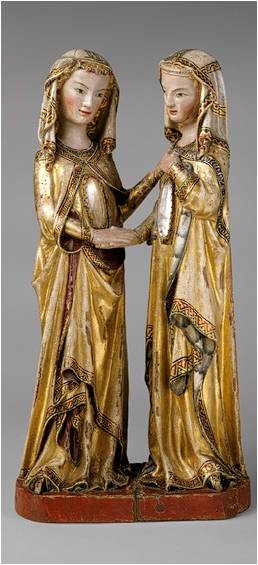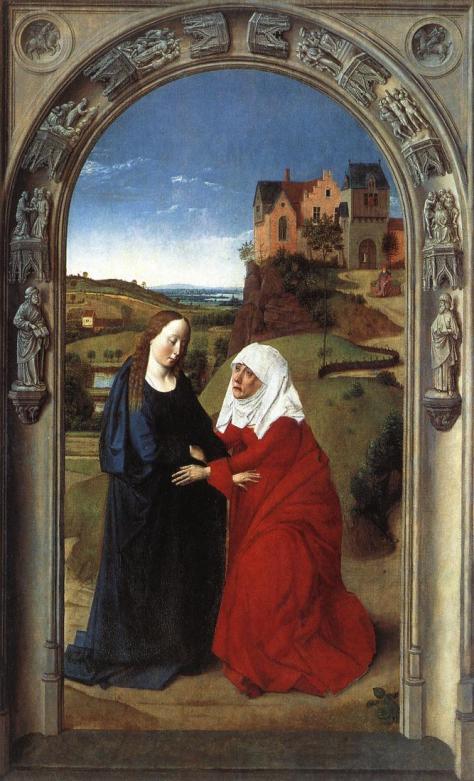Mary set out
and traveled to the hill country in haste
to a town of Judah,
where she entered the house of Zechariah
and greeted Elizabeth.
When Elizabeth heard Mary’s greeting,
the infant leaped in her womb,
and Elizabeth, filled with the Holy Spirit,
cried out in a loud voice and said,
“Blessed are you among women,
and blessed is the fruit of your womb.
And how does this happen to me,
that the mother of my Lord should come to me?
For at the moment the sound of your greeting reached my ears,
the infant in my womb leaped for joy.
Blessed are you who believed
that what was spoken to you by the Lord
would be fulfilled.”
Luke 1:39-45
Mariotto Alberti’s painting of the Visitation, is considered to be the masterpiece of a relatively minor Renaissance artist. In this work we see the harmony and realism, luminous colors, volumetric modelling of the figures, and architectural perspective of the High Renaissance. In Giorgio Vasari’s Lives of the Most Excellent Painters, Sculptors, and Architects, published in 1550, he wrote of the artist:
Mariotto was a most restless person and carnal in the affairs of love and apt to the art of living, and, taking a dislike to the studies and brain-wracking necessary to painting, being also often stung by the tongues of other painters, as is their way, he resolved to give himself to a less laborious and more jovial profession, and so opened the most lovely hostelry outside the Porta San Gallo, and at the sign of the Dragon at the Ponte Vecchioa tavern and inn. This life he led for many months, saying that he had taken up an art that was without muscles, foreshortening or perspective and, better still, without faultfinding, and that the art that he had given up imitated flesh and blood, but this one created flesh and blood; in this if you had good wine you heard yourself praised, but in that every day you were blamed. But at last the low life became an annoyance to him, and, filled with remorse, he returned to painting.

The Visitation, ca. 1310, Attributed to Master Heinrich of Constance, German,
Metropolitan Museum of Art,
New York
This delightful sculpture, less than two feet tall, comes from the Met:
“This representation of Mary and Elizabeth’s joyous meeting comes from the Dominican convent of Katharinenthal, in the Lake Constance region of present-day Switzerland. Carved of walnut, with the original paint and gilding almost completely preserved, the figures of Mary and Elizabeth are each inset with crystal-covered cavities through which images of their infants may originally have been seen. The representation of the Visitation, incorporating images of the unborn Christ and John the Baptist, is found with some frequency in late medieval works from German-speaking lands.”
Dieric Bouts is one of my favorite artists of the Northern Renaissance. This polyptych, a four-part altarpiece, shows the Annunciation, Visitation, Adoration of Angels, and the Adoration of the Magi.
The architectural frames of the panels are based on Rogier Van der Weyden’s Miraflores Triptych in Berlin; it evokes the entrance to a Gothic portico, and alludes to the New Law that is brought about with the birth of Christ.
The biblical passages in the archivolts strengthen this idea:
- in the first panel, showing the Annunciation, the framing arch is decorated with the story of Adam and Eve;
- in the central panel, the arches of the Visitation and the Nativity show scenes from the Passion of Christ;
- in the Epiphany, the arc is decorated with episodes which followed the Resurrection, alluding to the universality of Christianity.
Van der Weyden’s influence is clearest in the Visitation, but Bouts also draws on the art of Van Eyck in his concern for light and color, while his interest in landscape denotes the influence of his native Holland. Bouts never saw the Holy Land but he is known for including landscapes of his native countryside in his works, as we see here.
In the Visitation, note the age difference between the two women, with Mary radiantly youthful and Elizabeth wrinkled with age. I love the way they tenderly touch each others’ pregnant belly, such a loving and intimate gesture.
That gesture helped me make a connection with the story that I hadn’t experienced before. Imagine yourself in the scene and that you are touching the Virgin Mary’s pregnant belly; feel the baby inside her move and kick. Imagine your startled joy, just as John the Baptist leaped in Elizabeth’s womb! This encounter makes Elizabeth sing out her praise; what sort of praise is breaking forth from you?




